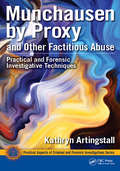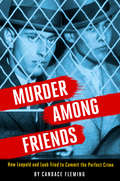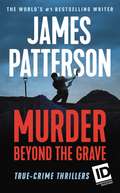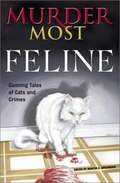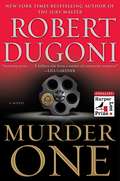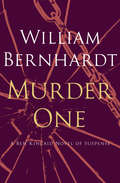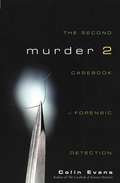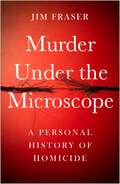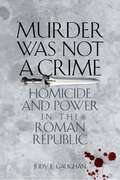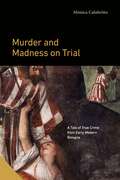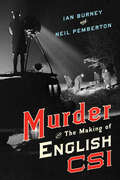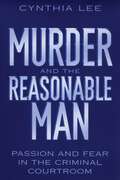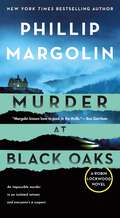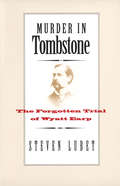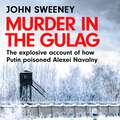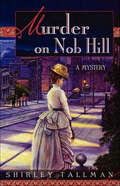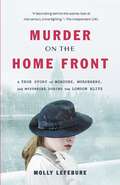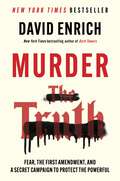- Table View
- List View
Multisystemic Therapy for Antisocial Behavior in Children and Adolescents
by Scott Henggeler Sonja SchoenwaldMultisystemic therapy (MST) has grown dramatically since the initial publication of this comprehensive manual. Today, over 400 MST programs operate in more than 30 states and 10 countries, supported by a strong empirical evidence base. This book explains the principles of MST and provides clear guidelines for clinical assessment and intervention with delinquent youth and their families. Practitioners are guided to implement proven strategies for engaging clients and helping them to address the root causes of antisocial behavior, improve family functioning and peer relationships, enhance school performance, and build meaningful social supports. New to This Edition Includes the latest MST data and clinical refinements. Revised to be even more user-friendly, with many new examples added. A chapter on treating youth and caregiver substance abuse. Expanded coverage of safety concerns, enhancing vocational outcomes, and MST adaptations for other clinical problems. A chapter detailing the MST system for sustaining high-quality programs.
Munchausen by Proxy and Other Factitious Abuse: Practical and Forensic Investigative Techniques (Practical Aspects of Criminal and Forensic Investigations #64)
by Kathryn ArtingstallThis book covers Munchausen and Munchausen by Proxy (MBP) though the terms have recently changed. The 2013 DSM-V—the update to the American Psychiatric Association's (APA) diagnostic and classification tool—has classified both Munchausen and MBP as "Factitious Systematic Abuse." While thought to have occurred primarily with children and their caregivers, recent research shows a more widespread problem: such medical abuse to spouses, the disabled, the elderly—even pets. Many involve repeat and long-term instances of hospital and medical fraud. This book covers the syndrome itself, interviewing and investigative aspects, victimology, as well indicators in the event of homicide and death.
Murder Among Friends: How Leopold and Loeb Tried to Commit the Perfect Crime
by Candace FlemingHow did two teenagers brutally murder an innocent child...and why? And how did their brilliant lawyer save them from the death penalty in 1920s Chicago? Written by a prolific master of narrative nonfiction, this is a compulsively readable true-crime story based on an event dubbed the "crime of the century."In 1924, eighteen-year-old college students Nathan Leopold and Richard Loeb made a decision: they would commit the perfect crime by kidnapping and murdering a child they both knew. But they made one crucial error: as they were disposing of the body of young Bobby Franks, whom they had bludgeoned to death, Nathan's eyeglasses fell from his jacket pocket.Multi-award-winning author Candace Fleming depicts every twist and turn of this harrowing case--how two wealthy, brilliant young men planned and committed what became known as the crime of the century, how they were caught, why they confessed, and how the renowned criminal defense attorney Clarence Darrow enabled them to avoid the death penalty.Following on the success of such books as The Rise and Fall of Charles Lindbergh and The Family Romanov, this acclaimed nonfiction writer brings to heart-stopping life one of the most notorious crimes in our country's history.
Murder Beyond the Grave: True-crime Thrillers (James Patterson's Murder is Forever #3)
by James Patterson<P>Two true-crime thrillers as seen on Discovery's Murder is Forever TV series - premiering February 2018 <P>MURDER BEYOND THE GRAVE. <P>Stephen Small has it all-a Ferrari, fancy house, loving wife, and three boys. But the only thing he needs right now is enough air to breathe. Kidnapped, buried in a box, and held for ransom, Stephen has forty-eight hours of oxygen. The clock is ticking . . . <P>MURDER IN PARADISE. <P>High in the Sierra Nevada mountains, developers Jim and Bonnie Hood excitedly tour Camp Nelson Lodge. They intend to buy and modernize this beautiful rustic property, but the locals don't like rich outsiders changing their way of life. After a grisly shooting, everybody will discover just how you can make a killing in real estate . . . <P><b>A New York Times Bestseller</b>
Murder Most Feline: Cunning Tales of Cats and Crime
by Ed Gorman Larry Segriff Martin H. GreenbergWHEN LAW MEETS PAW The result is this delightful anthology of sixteen original courtroom tales by top-notch mystery writers. Always dignified, cats are quick to mete out their own justice with a claw or a bite, and so it is only natural that we find them in a variety of roles in these feline mysteries. Cats take the stand in their defense to pounce on criminals, provide evidence, and turn the legal system on its collective ear—all in the name of justice. From a private eye who goes to bat for a cat's inheritance to a common mouser who turns out to be quite a bit more during a high-profile murder trial, these tales of crime are as crafty and cunning as cats themselves—and just as entertaining. In a section of Author Biographies after the primary content readers are given the opportunity to discover additional stories and novels by the authors they have particularly liked. Authors include: Ann Barrett, Gary A. Braunbeck, Richard Chizmar, Barry Hoffman, Bill Crider, Janet Dawson, Parnell Hall, Tracy Knight, Shirley R. Murphy, Dulcy Brainard, Jon L. Breen, Matthew J. Costello, Mat Coward, Catherine Dain, Jan Grape, Jeremiah Healy, Dick Lochte
Murder One
by Robert DugoniFinalist for the Harper Lee Prize for Legal Fiction:New York Times bestselling author Robert Dugoni delivers another gripping legal thriller in his popular David Sloane series. The case? Defending the woman he loves against a charge of murder. A year after the devastating murder of his wife, attorney David Sloane has returned to Seattle after three months in Mexico. At a black-tie dinner where he's been persuaded to give the keynote address, Sloane reconnects with Barclay Reid, opposing counsel in his most prominent case. Barclay is suffering from her own personal tragedy--the death of her teenage daughter from a drug overdose. In the aftermath, Barclay has begun an intense crusade against the Russian drug traffickers she holds responsible for her daughter's death, pursuing them with a righteousness that matches Sloane's own zeal for justice. Despite their adversarial past, Sloane is drawn to Barclay and for the first time since his wife died, he finds himself beginning to have romantic feelings again. But when Barclay's crusade stalls and a Russian drug dealer turns up dead, she stands accused of murder, and Sloane is her chosen defender. Amid the swirling media frenzy, in his first criminal case, Sloane finds himself once again in harm's way, while mounting evidence suggests that Barclay is a woman with many secrets--and may not be quite as innocent as she seems. With his signature fast-paced, page-turning action and exhilarating plot twists, Robert Dugoni once again proves why he's so often been named the heir to Grisham's literary throne.
Murder One
by Robert DugoniFinalist for the Harper Lee Prize for Legal Fiction:New York Times bestselling author Robert Dugoni delivers another gripping legal thriller in his popular David Sloane series. The case? Defending the woman he loves against a charge of murder.A year after the devastating murder of his wife, attorney David Sloane has returned to Seattle after three months in Mexico. At a black-tie dinner where he's been persuaded to give the keynote address, Sloane reconnects with Barclay Reid, opposing counsel in his most prominent case. Barclay is suffering from her own personal tragedy--the death of her teenage daughter from a drug overdose. In the aftermath, Barclay has begun an intense crusade against the Russian drug traffickers she holds responsible for her daughter's death, pursuing them with a righteousness that matches Sloane's own zeal for justice. Despite their adversarial past, Sloane is drawn to Barclay and for the first time since his wife died, he finds himself beginning to have romantic feelings again. But when Barclay's crusade stalls and a Russian drug dealer turns up dead, she stands accused of murder, and Sloane is her chosen defender. Amid the swirling media frenzy, in his first criminal case, Sloane finds himself once again in harm's way, while mounting evidence suggests that Barclay is a woman with many secrets--and may not be quite as innocent as she seems. With his signature fast-paced, page-turning action and exhilarating plot twists, Robert Dugoni once again proves why he's so often been named the heir to Grisham's literary throne.
Murder One (The Ben Kincaid Novels #10)
by William BernhardtA cop killing pits defense attorney Ben Kincaid against the boys in blue in this national bestseller. &“Outstanding . . . amazing . . . You never see the ending coming&” (Tulsa World). It is one of the most gruesome murders Oklahoma has ever seen. A horribly mutilated man is found chained to a statue in the middle of downtown Tulsa, secured so tightly that it takes the police hours to get him down. As the city&’s workforce stares, the police realize something terrible: The victim is one of their own. They arrest the dead cop&’s girlfriend, a nineteen-year-old stripper whose camera-ready appearance quickly turns the trial into a media circus. And when idealistic young defense attorney Ben Kincaid gets the dancer off on a technicality, the city erupts. Unable to try their suspect a second time, the Tulsa police build a case against Kincaid, arresting him after they stumble across the murder weapon in his office. Every instrument in the state&’s justice system is turned against him, but Kincaid isn&’t worried. He&’s faced worse odds before.
Murder Two: The Second Casebook of Forensic Detection
by Colin EvansA murdered scientist points her finger from the grave at her brutal killer. A Stone Age homicide comes to light after 5,300 years. A serial killer who slays women on two continents is finally brought to justice by a single hair that yields just nine billionths of a gram of human DNA. All these miracles of detection were made possible only by the crime lab, our leading weapon in the war on crime. If you are fascinated by both the history of forensics and the very latest developments in crime scene investigation, autopsies, and other aspects of the science, Murder Two is the book for you. This comprehensive casebook of forensic detection presents nearly one hundred classic, high-profile cases in which police detectives and crime labs worked together to solve baffling and horrifying crimes through the shrewd, painstaking use of science. Spanning four continents and almost two hundred years, these cases feature the forensic quirks, wrinkles, and breakthroughs that led to major advances in crime detection.
Murder Under the Microscope: A Personal History of Homicide
by Jim Fraser'Jim Fraser has been at the forefront of forensic science in the UK for decades... A superb story of real-life CSI.' Dr Richard Shepherd, bestselling author of Unnatural Causes 'Powerful... Fascinating' Independent Most murders are not difficult to solve. People are usually killed by someone they know, there is usually abundant evidence and the police methods used to investigate this type of crime are highly effective. But what about the more difficult cases, where the investigation involves an unusual death, an unusual killer, or is complex or politically charged? In these cases, bringing the accused before the courts can take many years, even then, the outcome may be contentious or unresolved. In this compelling and chilling memoir, Jim Fraser draws on his personal experience as a forensic scientist and cold case reviewer to give a unique insight into some of the most notable cases that he has investigated during his forty-year career, including the deaths of Rachel Nickell, Damilola Taylor and Gareth Williams, the GCHQ code breaker. Inviting the reader into the forensic scientist's micro-world, Murder Under the Microscope reveals not only how each of these cases unfolded as a human, investigative and scientific puzzle, but also why some were solved and why others remain unsolved or controversial even to this day.
Murder Was Not a Crime: Homicide and Power in the Roman Republic (Ashley and Peter Larkin Series in Greek and Roman Culture)
by Judy E. GaughanEmbarking on a unique study of Roman criminal law, Judy Gaughan has developed a novel understanding of the nature of social and political power dynamics in republican government. Revealing the significant relationship between political power and attitudes toward homicide in the Roman republic, Murder Was Not a Crime describes a legal system through which families (rather than the government) were given the power to mete out punishment for murder. With implications that could modify the most fundamental beliefs about the Roman republic, Gaughan’s research maintains that Roman criminal law did not contain a specific enactment against murder, although it had done so prior to the overthrow of the monarchy. While kings felt an imperative to hold monopoly over the power to kill, Gaughan argues, the republic phase ushered in a form of decentralized government that did not see itself as vulnerable to challenge by an act of murder. And the power possessed by individual families ensured that the government would not attain the responsibility for punishing homicidal violence. Drawing on surviving Roman laws and literary sources, Murder Was Not a Crime also explores the dictator Sulla’s “murder law,” arguing that it lacked any government concept of murder and was instead simply a collection of earlier statutes repressing poisoning, arson, and the carrying of weapons. Reinterpreting a spectrum of scenarios, Gaughan makes new distinctions between the paternal head of household and his power over life and death, versus the power of consuls and praetors to command and kill.
Murder Was Not a Crime: Homicide and Power in the Roman Republic (Ashley and Peter Larkin Series in Greek and Roman Culture)
by Judy E. GaughanEmbarking on a unique study of Roman criminal law, Judy Gaughan has developed a novel understanding of the nature of social and political power dynamics in republican government. Revealing the significant relationship between political power and attitudes toward homicide in the Roman republic, Murder Was Not a Crime describes a legal system through which families (rather than the government) were given the power to mete out punishment for murder. With implications that could modify the most fundamental beliefs about the Roman republic, Gaughan's research maintains that Roman criminal law did not contain a specific enactment against murder, although it had done so prior to the overthrow of the monarchy. While kings felt an imperative to hold monopoly over the power to kill, Gaughan argues, the republic phase ushered in a form of decentralized government that did not see itself as vulnerable to challenge by an act of murder. And the power possessed by individual families ensured that the government would not attain the responsibility for punishing homicidal violence. Drawing on surviving Roman laws and literary sources, Murder Was Not a Crime also explores the dictator Sulla's "murder law," arguing that it lacked any government concept of murder and was instead simply a collection of earlier statutes repressing poisoning, arson, and the carrying of weapons. Reinterpreting a spectrum of scenarios, Gaughan makes new distinctions between the paternal head of household and his power over life and death, versus the power of consuls and praetors to command and kill.
Murder and Madness on Trial: A Tale of True Crime from Early Modern Bologna (Interactions in the Early Modern Age)
by Mònica CalabrittoOn October 24, 1588, Paolo Barbieri murdered his wife, Isabella Caccianemici, stabbing her to death with his sword. Later, Paolo would claim to have acted in a fit of madness—but was he criminally insane or merely pretending to be? In this riveting book, Mònica Calabritto addresses this controversy by reconstructing Paolo’s life, prosecution, and medical diagnoses.Skillfully combining archival documents unearthed throughout Italy, Calabritto brings to light the case of one person and his family as insanity ravaged their financial security, honor, and reputation. The very notion of insanity is as much on trial in Paolo’s case as the defendant himself. A case study in the diagnosis of insanity in the early modern era, Barbieri’s story reveals discrepancies between medical and legal definitions of a person’s mental state at the time of a crime. Murder and Madness on Trial bridges the micro-historical dimensions of Paolo’s murder case and the macro-historical perspectives on medical and legal evidence used to identify intermittent madness.A tragic and gripping tale, Murder and Madness on Trial allows readers to look “through a glass darkly” at early modern violence, madness, criminal justice, medical and legal expertise, and the construction and circulation of news. This erudite and engaging book will appeal to early modern historians and true crime fans alike.
Murder and Media in the New Rome
by Thomas SimpsonAn insightful look into the origins of modern Italian media culture by examining a sensational crime and trial that took place in Rome in the late 1870s, when a bloody murder triggered a national spectacle that became the first great media circus in the new nation of Italy, crucially shaping the young state's public sphere and image of itself.
Murder and the Making of English CSI
by Ian Burney Neil PembertonThe engrossing account of how science-based forensics transformed the investigation of twentieth-century murders and in the process invented CSI.Crime scene investigation—or CSI—has captured the modern imagination. On television screens and in newspapers, we follow the exploits of forensic officers wearing protective suits and working behind police tape to identify and secure physical evidence for laboratory analysis. But where did this ensemble of investigative specialists and scientific techniques come from? In Murder and the Making of English CSI, Ian Burney and Neil Pemberton tell the engrossing history of how, in the first half of the twentieth century, novel routines, regulations, and techniques—from chain-of-custody procedures to the analysis of hair, blood, and fiber—fundamentally transformed the processing of murder scenes. Focusing on two iconic English investigations—the 1924 case of Emily Kaye, who was beaten and dismembered by her lover at a lonely beachfront holiday cottage, and the 1953 investigation into John Christie’s serial murders in his dingy terraced home in London’s West End—Burney and Pemberton chart the emergence of the crime scene as a new space of forensic activity. Drawing on fascinating source material ranging from how-to investigator handbooks and detective novels to crime journalism, police case reports, and courtroom transcripts, the book shows readers how, over time, the focus of murder inquiries shifted from a primarily medical and autopsy-based interest in the victim’s body to one dominated by laboratory technicians laboring over minute trace evidence. Murder and the Making of English CSI reveals the compelling and untold story of how one of the most iconic features of our present-day forensic landscape came into being. It is a must-read for forensic scientists, historians, and true crime devotees alike.
Murder and the Making of English CSI
by Ian Burney Neil PembertonA history of the origins and development of forensic science in murder investigations in early twentieth-century England.Crime scene investigation—or CSI—has captured the modern imagination. On television screens and in newspapers, we follow the exploits of forensic officers wearing protective suits and working behind police tape to identify and secure physical evidence for laboratory analysis. But where did this ensemble of investigative specialists and scientific techniques come from?In Murder and the Making of English CSI, Ian Burney and Neil Pemberton tell the engrossing history of how, in the first half of the twentieth century, novel routines, regulations, and techniques—from chain-of-custody procedures to the analysis of hair, blood, and fiber—fundamentally transformed the processing of murder scenes. Focusing on two iconic English investigations—the 1924 case of Emily Kaye, who was beaten and dismembered by her lover at a lonely beachfront holiday cottage, and the 1953 investigation into John Christie’s serial murders in his dingy terraced home in London’s West End—Burney and Pemberton chart the emergence of the crime scene as a new space of forensic activity.Drawing on fascinating source material ranging from how-to investigator handbooks and detective novels to crime journalism, police case reports, and courtroom transcripts, the book shows readers how, over time, the focus of murder inquiries shifted from a primarily medical and autopsy-based interest in the victim’s body to one dominated by laboratory technicians laboring over minute trace evidence. Murder and the Making of English CSI reveals the compelling and untold story of how one of the most iconic features of our present-day forensic landscape came into being. It is a must-read for forensic scientists, historians, and true crime devotees alike.“Out of some pretty gruesome parts, Burney and Pemberton have assembled a remarkably elegant account of the making of modern murder investigation. Their analysis combines scholarly sophistication with a clarity of prose that entertains, informs, and surprises. Murder and the Making of English CSI brims with insight about the historical path that led to our forensic present.” —Mario Biagioli, UC Davis School of Law, author of Galileo's Instruments of Credit: Telescopes, Images, Secrecy“This nuanced and fascinating history of English crime scene reconstruction has an uncanny prescience for today’s debates about how to manage crime scene evidence.” —Simon A. Cole, University of California, Irvine, author of Suspect Identities: A History of Fingerprinting and Criminal Identification
Murder and the Reasonable Man: Passion and Fear in the Criminal Courtroom (Critical America #37)
by Cynthia LeeA man murders his wife after she has admitted her infidelity; another man kills an openly gay teammate after receiving a massage; a third man, white, goes for a jog in a “bad” neighborhood, carrying a pistol, and shoots an African American teenager who had his hands in his pockets. When brought before the criminal justice system, all three men argue that they should be found “not guilty”; the first two use the defense of provocation, while the third argues he used his gun in self-defense.Drawing upon these and similar cases, Cynthia Lee shows how two well-established, traditional criminal law defenses—the doctrines of provocation and self-defense—enable majority-culture defendants to justify their acts of violence. While the reasonableness requirement, inherent in both defenses, is designed to allow community input and provide greater flexibility in legal decision-making, the requirement also allows majority-culture defendants to rely on dominant social norms, such as masculinity, heterosexuality, and race (i.e., racial stereotypes), to bolster their claims of reasonableness. At the same time, Lee examines other cases that demonstrate that the reasonableness requirement tends to exclude the perspectives of minorities, such as heterosexual women, gays and lesbians, and persons of color.Murder and the Reasonable Man not only shows how largely invisible social norms and beliefs influence the outcomes of certain criminal cases, but goes further, suggesting three tentative legal reforms to address problems of bias and undue leniency. Ultimately, Lee cautions that the true solution lies in a change in social attitudes.
Murder at Black Oaks: A Robin Lockwood Novel (Robin Lockwood #6)
by Phillip MargolinIn Phillip Margolin's Murder at Black Oaks, Attorney Robin Lockwood finds herself at an isolated retreat in the Oregon mountains, one with a tragic past and a legendary curse, and surrounded by many suspects and confronted with an impossible crime.Defense Attorney Robin Lockwood is summoned by retired District Attorney Francis Melville to meet with him at Black Oaks, the manor he owns up in the Oregon mountains. The manor has an interesting history - originally built in 1628 in England, there's a murderous legend and curse attached to the mansion. Melville, however, wants Lockwood's help in a legal matter - righting a wrongful conviction from his days as a DA. A young man, Jose Alvarez, was convicted of murdering his girlfriend only for Melville, years later when in private practice, to have a client of his admit to the murder and to framing the man Melville convicted. Unable to reveal what he knew due to attorney client confidence, Melville now wants Lockwood's help in getting that conviction overturned.Successful in their efforts, Melville invites Lockwood up to Black Oaks for a celebration. Lockwood finds herself among an odd group of invitees - including the bitter, newly released, Alvarez. When Melville is found murdered, with a knife connected to the original curse, Lockwood finds herself faced with a conundrum - who is the murder among them and how to stop them before there's another victim.
Murder in Tombstone: The Forgotten Trial of Wyatt Earp (The Lamar Series in Western History)
by Steven LubetThis account of the court case that followed the gunfight at the OK Corral &“will interest Wild West buffs as well as readers interested in legal history&” (Publishers Weekly). The gunfight at the OK Corral lasted less than a minute—yet it became the basis for countless stories about the Wild West. At the time of the event, however, Wyatt Earp was not universally acclaimed as a hero. Among the people who knew him best in Tombstone, Arizona, many considered him a renegade and murderer. This book tells the nearly unknown story of the prosecution of Wyatt Earp, his brothers, and Doc Holiday following the famous gunfight. To the prosecutors, the Earps and Holiday were wanton killers. According to the defense, the Earps were steadfast heroes—willing to risk their lives on the mean streets of Tombstone for the sake of order. The case against the Earps, with its dueling narratives of brutality and justification, played out themes of betrayal, revenge, and even adultery. Attorney Thomas Fitch, one of the era&’s finest advocates, ultimately managed, against considerable odds, to save Earp from the gallows. But the case could easily have ended in a conviction—and Wyatt Earp would have been hanged or imprisoned instead of celebrated as an American icon. &“This trial has everything: a family feud, famous outlaws and lawmen, politics, sex, and the most famous shootout in frontier history . . . Lubet&’s accessible and highly original book will set a standard for scholarship in a field laden with folklore.&” —Allen Barra, author of Inventing Wyatt Earp
Murder in the Gulag: The explosive account of how Putin poisoned Alexei Navalny
by John Sweeney'Murder in the Gulag is brilliant journalistic writing: punchy, eloquent, page-turning and factual. It's a powerful reminder of what an extraordinary man Navalny was' - Roland Oliphant, TelegraphThe gripping sequel to the bestselling Killer in the Kremlin2:19pm, Moscow time, 16 February 2024. The Federal Penitentiary Service of the Yamalo-Nenets Autonomous District announces that Alexei Navalny is dead. The news sends shockwaves around the world.In Murder in the Gulag, award-winning journalist John Sweeney goes behind the headlines to reveal what really happened to the Russian opposition leader in the freezing Polar Wolf penal colony in a remote part of Siberia. The book is less a whodunnit - Russian President Vladimir Putin's machinery of repression killed Navalny - than a howdunnit.The narrative relates Navalny's extraordinary life story in technicolour detail, from his childhood summers spent with his grandparents in the shadow of the Chernobyl nuclear plant in Ukraine to his untimely death at the age of 47, cut down in his prime.This is a warts-and-all portrayal of a highly charismatic but controversial figure who flirted with far-right Russian nationalists before course-correcting, told by an intrepid journalist, based in London and Kyiv, who knew Navalny personally.Murder in the Gulag contains a warning. Navalny made a fatal misjudgement in returning to Russia after his poisoning by Novichok in 2020, betting that Vladimir Putin wouldn't kill him. But as Putin has gained in strength, with the death of Wagner leader Yevgeny Prigozhin and the fortunes of war slowly turning in Russia's favour, Navalny lost that bet. Sweeney argues that if the West fails to stand up more forcefully to Putin, we are in danger not just of betraying Ukraine but our own security too.
Murder in the Gulag: The explosive account of how Putin poisoned Alexei Navalny
by John Sweeney'Murder in the Gulag is brilliant journalistic writing: punchy, eloquent, page-turning and factual. It's a powerful reminder of what an extraordinary man Navalny was' - Roland Oliphant, TelegraphIn this revised and updated paperback edition, award-winning journalist John Sweeney goes behind the headlines to investigate what really happened to Alexei Navalny in the freezing Polar Wolf penal colony in a remote part of Siberia in February 2024. This is a warts-and-all portrayal of the highly charismatic but controversial Russian opposition leader who at one time flirted with the far right. Murder in the Gulag lifts the lid on the reality of life in Russia today and asks what Navalny's death means for the future of Putin, Russia and the West.
Murder in the Gulag: The explosive account of how Putin poisoned Alexei Navalny
by John Sweeney'Murder in the Gulag is brilliant journalistic writing: punchy, eloquent, page-turning and factual. It's a powerful reminder of what an extraordinary man Navalny was' - Roland Oliphant, TelegraphIn this revised and updated paperback edition, award-winning journalist John Sweeney goes behind the headlines to investigate what really happened to Alexei Navalny in the freezing Polar Wolf penal colony in a remote part of Siberia in February 2024. This is a warts-and-all portrayal of the highly charismatic but controversial Russian opposition leader who at one time flirted with the far right. Murder in the Gulag lifts the lid on the reality of life in Russia today and asks what Navalny's death means for the future of Putin, Russia and the West.
Murder on Nob Hill: A Mystery (Sarah Woolson Mysteries #1)
by Shirley TallmanThe year is 1880, the place San Francisco. Intelligent, outspoken Sarah Woolson is a young woman with a goal and the fortitude to achieve it. She has always dreamed of becoming a lawyer. The trouble is, everyone believes women belong in the home---that it is not only unnatural, but against God's will for them to seek a career.When Sarah finagles an interview with one of the city's most prestigious law firms, no one thinks she has a prayer of being hired. Except Sarah. Using her brains and a little subterfuge, she not only manages to become the firm's newest (and only female) associate attorney, she also acquires her first client---a lovely young society matron suspected of brutally stabbing to death her wealthy but abusive husband. Sarah is sure of her client's innocence, but the revelation of the woman's secret lover may make that innocence impossible to prove.When four more victims fall prey to the killer's knife, Sarah fears she has bitten off more than she can chew. Bucking her boorish employer and the judicial system, Sarah finds herself embroiled in shady legal maneuvers, a daring Chinatown raid, and a secret and very scandalous sex club in this irresistible blend of history, romance, and murder.
Murder on the Home Front: A True Story of Morgues, Murderers, and Mysteries during the London Blitz
by Molly LefebureIt is 1941. While the "war of chaos" rages in the skies above London, an unending fight against violence, murder and the criminal underworld continues on the streets below.One ordinary day, in an ordinary courtroom, forensic pathologist Dr. Keith Simpson asks a keen young journalist to be his secretary. Although the "horrors of secretarial work" don't appeal to Molly Lefebure, she's intrigued to know exactly what goes on behind a mortuary door.Capable and curious, "Miss Molly" quickly becomes indispensible to Dr. Simpson as he meticulously pursues the truth. Accompanying him from somber morgues to London's most gruesome crime scenes, Molly observes and assists as he uncovers the dark secrets that all murder victims keep.With a sharp sense of humor and a rebellious spirit, Molly tells her own remarkable true story here with warmth and wit, painting a vivid portrait of wartime London.
Murder the Truth: Fear, the First Amendment, and a Secret Campaign to Protect the Powerful
by David Enrich"Authoritarian governments abroad have long used legal threats and lawsuits against journalists to cover up their disinformation, corruption, and violence. Now, as master investigative journalist David Enrich reveals, those tactics have arrived in America.” — Ruth Ben-Ghiat, author of Strongmen. <p> David Enrich, the New York Times Business Investigations Editor and the #1 bestselling author of Dark Towers, produces his most consequential and far-reaching investigation yet: an in-depth exposé of the broad campaign—orchestrated by elite Americans—to silence dissent and protect the powerful. <p> It was a quiet way to announce a revolution: In an obscure 2019 case that the Supreme Court refused to even hear, Justice Clarence Thomas raised the prospect of overturning the legendary New York Times v. Sullivan decision. Though hardly a household name, Sullivan is one of the most consequential free speech decisions, ever. Fundamental to the creation of the modern media as we know it, it has enabled journalists and writers all over the country—from top national publications to revered local newspapers to independent bloggers—to pursue the truth aggressively and hold the wealthy, powerful, and corrupt to account. <p> Thomas’s words were a warning—the public awakening of an idea that had been fomenting on the conservative fringe for years. Now it is going mainstream. From the Florida statehouse to small town New Hampshire to Donald Trump's White House, this movement today consists of some of the world’s richest and most powerful people and companies, who believe they should be above scrutiny and want to silence or delegitimize voices that challenge their supremacy. Indeed, many of the same businessmen, politicians, lawyers, and activists are already weaponizing the legal system to intimidate and punish journalists and others who dare criticize them. <p> In this masterwork of investigative reporting, David Enrich, New York Times Business Investigations Editor, traces the roots and reach of this growing threat to our modern democracy. With Trump’s emboldened right-wing coalition committed to demonizing and punishing those who attempt to hold them accountable, Murder the Truth sounds the alarm about the looming war over facts, laying bare the stakes of losing our most sacrosanct rights. The result is a story about power in the age of Trump—the way it’s used by those who have it and the lengths to which they will go to avoid it being questioned. <b>New York Times Bestseller</b>

